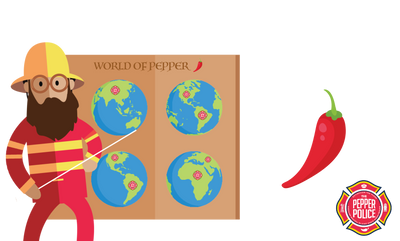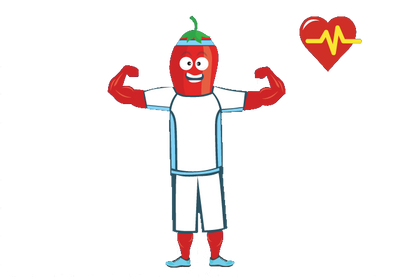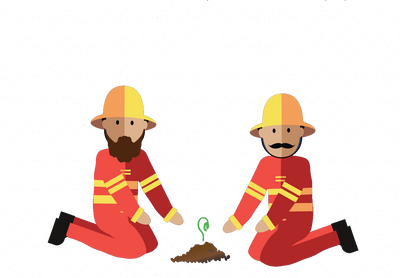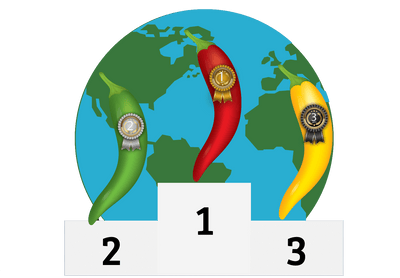
World of Pepper
Anything and Everything Chili Pepper.
Every Second. Every Minute. All day. Every day.
Chili Pepper Health Benefits

•Chilies are high in vitamin C (about twice that of citrus fruits), dried chilies are very high in vitamin A, and red chilies are a great source of b-carotene.
•Chilies have antibacterial qualities, and contain bioflavonoids, anti-oxidants most common in apple juice.
•Endorphins are a class of neurotransmitters produced by the body and used internally as a pain killer. This class of compounds are similar in their action to opiates, attaching to some of the same receptors in the brain. They are a strong analgesic, and give a pervasive sense of happiness. They are proteins, and due to their many different types and their complexity, I cannot list them here. The release of endorphins lowers the blood pressure, a major indicator in heart disease, and has even been implicated in the fight against cancer.
•Endorphins are best known to those who exercise a lot, and give rise to what is known as the 'runner's high'. Their release is caused by all pain, including that caused by chilies. Thus a dose of hot chilies will cause the release of these compounds, without any permanent harm.
•Some people find the 'rush' from endorphins addictive, and may exercise excessively, have many tattoos or piercings, or even deliberately cut themselves. I think chilies are by far the safest, easiest, and tastiest way to get an endorphin response.
•Capsaicin also has some nice medicinal properties to it as an anti fungal and anti-microbial agent. In addition, due to the capsaicin tricking the brain into thinking your mouth is being burned when you eat it, your brain will release endorphins thus producing a sense of well being. Also in response to being “burned”, your brain will boost your metabolism, among other things.
•Ironically capsaicin is also currently used as a pain reliever, such as in cream for arthritis suffers with about a .05% level of capsaicin in the cream. How they do this is they first numb the skin, then apply the cream and wait for the patient to start feeling the heat; they then remove the cream. This method is very effective in reducing joint and other arthritic pains. Indeed, capsaicin is the primary ingredient in the drug “Adlea”, which is a very long acting drug to treat post surgical and arthritic pain. A single injection of Adlea to the site of the pain will reduce pain for up to a few months in the area injected.
•Recently it has also been found that capsaicin is able to kill prostate cancer cells. In the study, the tumors that were treated with capsaicin ended up shrinking to about 1/5 the size of the tumors that were not in the control group. Capsaicin also has been shown to inhibit the growth of Leukemic cells. In yet another study, it has been shown to be effective in triggering Apoptosis in lung cancer cells, which is the process of programmed cell death.
•Metabolism
•Spicy foods not only increase body temperature, but also might boost your metabolism. Scientists at Daegu University in Korea found that rats following a high-fat diet with capsaicin experienced more reductions in body fat than rats fed a high-fat diet without capsaicin. Researchers found that capsaicin increases the production of proteins inside fat cells that help break down fat, thereby reducing the size of fat cells. Furthermore, capsaicin significantly reduced the synthesis of new fat cells, according to research reported in the April 2010 issue of the "Journal of Proteome Research." Further research on humans is necessary.
•Blood Pressure
•High blood pressure forces your heart to work harder to pump blood through your body and damages blood vessels that supply nutrients to your organs. Over time, this increases your risk for illness. Researchers at the Third Military Medical University in China discovered that capsaicin increases the production of nitric oxide, a gas molecule that lowers blood pressure by dilating blood vessels and improving blood flow. The findings were published in the August 2010 issue of "Cell Metabolism."
•Possible Carcinogen
•Although capsaicin provides several benefits, it might also have adverse effects. Scientists at the University of Utah said capsaicin might act as a carcinogen, or cancer-causing agent. They found significantly higher rates of stomach and liver cancer in certain ethnic-cultural groups, such as Mexican-Americans, which consume high amounts of capsaicin. Further research is needed. The findings were reported in the October 2002 issue of "Medical Hypotheses."
Growing Chili Pepper 101

Classifying Capsicums
Chiles are perennial sub shrubs, native to South America, grown as annuals where freezing occurs. There are only a couple of places in the continental US that chiles can be grown as perennials: southern California, Florida, a very small portion of South Texas and a small area of southern Arizona. Chiles are not related to black pepper; however they are a part of the large nightshade family, which includes tomato, potato and eggplant. There are 5 domesticated species of chiles: Capsicum annuum which includes bells, New Mexicans, serrano's, jalapeños and piquins, Capsicum chinense which includes habaneros and the infamous ‘Datil’, Capsicum frutescens, which includes Tabasco® and the original ‘Malagueta’, Capsicum baccatum, which includes the ‘Christmas Bell’ and true ajis, and Capsicum pubescens, which includes rocotos and manzanos.
The Origin and Spread of Chiles
Chiles are believed to have originated in an area bordered by the mountains of Brazil, and Bolivia in South America. Over thousands of years chiles 'migrated' out of this area with the help of birds and natives and eventually spread across the Americas. The ancient wild chiles had small, round, erect, bright red fruits that made them very attractive to birds, and birds are unable to feel the pungency associated with capsaicin. It is believed this evolved in this way because a bird's digestive system does not harm seeds while a mammal does.
Preparing Your Garden
There is an overwhelming amount of chili pepper varieties available to the gardener. Many seed companies claim that all varieties grow well everywhere, this is not true. New Mexican varieties grow better in the southwest while bells and habaneros do not grow as well and grow better in other, more humid regions.
Garden Design - Some choices for growing chilies include:
•Ridges & Furrows
•Flat Beds
•Raised Beds
•Sunken Beds
•Containers
One key to growing chilies successfully is adding compost; this improves workability, water-holding capacity, drainage, and fertility.
Even under optimal conditions the germination process can be slow and irregular. Chile seeds need warmth, oxygen, and moisture to germinate. Higher germinations rates occur between 70 & 80 degrees F, while faster germination occurs between 90 & 100 degrees F. Soaking seeds for 2-3 days can also aid in the speed of germination. Fertility: Most gardeners can grow great chilies by simply adding compost and aged manure to their existing soil conditions, of course you have to manipulate the soil if it is excessively sandy or clay. Chilies are usually considered to be a self-pollinating crop, however, within species, will readily cross-pollinate. If you're planning to save seed take measures to protect your plants from cross-pollination.
Flower and fruit development, the key to flower set is nighttime temperature, which ideally should be between 65 and 80 degrees. Fruit set is enhanced by increased sunlight, however fruit will not set when night temperatures are above 86 degrees F. Some varieties will take 130 days or more to complete maturation. New Mexican pods ripening at temperatures between 86 & 95 degrees F have twice as many capsaicinoids as pods ripening between 59 & 72 degrees F.
Helpful Hints:
•Select early maturing varieties.
•Start seed indoors 8 to 10 weeks before the last expected frost.
•Before transplanting to a garden, "harden off" your seedlings by exposing them to outdoor temperatures (not freezing) for increasingly longer periods of time each day.
•Transplant when daytime temperatures average 70 degrees F and nighttime are around 55 degrees.
•Soil pH should be 6.5 and use of a balanced fertilizer is recommended (5-10-5 or 10-10-10.) Go easy on the Nitrogen.)
•Water during dry spells, at least 2 inches a week, especially after fruit set.
The Scoville Scale

The Scoville scale is the measurement of the pungency (spicy heat) of chili peppers or other spicy foods as reported in Scoville heat units (SHU), a function of capsaicin concentration. The scale is named after its creator, American pharmacist Wilbur Scoville. His method, devised in 1912, is known as the Scoville Organoleptic Test. However, the greatest weakness of the Scoville Organoleptic Test is its imprecision, because it relies on human subjectivity. Tasters are given only one sample per session. Results vary widely, up to 50%, between laboratories.
More scientifically, Spice heat is usually measured by a method that uses high performance liquid chromatography (HPLC). This identifies and measures the concentration of heat-producing chemicals. The measurements are used in a mathematical formula that weighs them according to their relative capacity to produce a sensation of heat. This method yields results, not in Scoville units, but in American Spice Trade Association (ASTA) pungency units. A measurement of one part capsaicin per million corresponds to about 15 Scoville units, and the published method says that ASTA pungency units can be multiplied by 15 and reported as Scoville units.
The World's Hottest Peppers

1. Carolina Reaper 2,200,000 SHU
There is nothing normal about this pepper. It was bred for heat and that it is. Oddly enough this pepper has excellent flavor as well. Officially the Worlds Hottest Pepper as ranked by Guinness Records.
2. Trinidad Scorpion Moruga Blend (Moruga Scorpion) 2,009,231 SHU
Straight from the depths of hell, Moruga Scorpion is a rare sought after pepper that was only just recently discovered
3. 7 Pot Brain Strain ~ 1,900,000 SHU
The Brain Strain, characterized by its bumpy/wavy skin that closely resembles a human brain. This pepper not only looks like brain, but sets it on FIRE! This pepper has insane heat!
4. 7 Pot Primo ~1,900,000 SHU
The 7 Pot Primo is very distinctive with its long skinny “tail”. Some recent peppers cultivators have tried to replicate this look because the tail is just terrifying. When you just look at this pepper, you know it’s going to be INSANELY hot.
5. 7 Pod Douglah (7 Pot Douglah, Chocolate 7 Pod, 7 Pot Brown) 1,853,936 SHU
Well renown in the pepper community as one of the hottest peppers with the best flavor. You can’t go wrong with fresh, dried, or powdered Douglah on any food
6. Trinidad Scorpion Butch T 1,463,700 SHU
Current Guiness Books of World Records holder. No doubt it’s insanely hot, but other peppers have been proven to be hotter.
7. Naga Viper 1,349,000 SHU
Extremely rare pepper cultivated in the UK. Combination of many different peppers and years of cross pollination created this variety of “Super HOT” pepper
8. Other 7 Pod Varieties (Red [Giant], Barrackpore, SR Strain, Primo, Jonah, Brain Strain, Yellow) 1,000,000 – 1,300,000 SHU
9. Bhut Jolokia (Ghost Pepper) 1,041,427 SHU
The most famous “Super Hot” due to the amount of press it has received in the past. Many mistakenly still believe it is the World’s Hottest.
10. Red Savina Habanero 500,000 SHU
Back in the early years of superhots the Red Savina Habanero was KING! He has since been dethroned and many peppers have passed him in heat. The Red Savina just barely makes the Top 10, but does so in fashion with its great flavor and extreme heat.
Where to Buy Pepper Seeds and Famous Sauces

Pepper Seeds
crazyhotseeds.com, pepperjoe.com,
puckerbuttpeppercompany.com
Online Retailers
chilliwillies.com,
bigdaddysassburn.com, pepperpalace.com, drosengarten.com,
extremefood.com, hotsaucezone.com,hotsauceworld.com, cajohns.com,
thechileshop.com
Pepper Festivals and Cook-Offs Around the World

www.pepperfestival.com
www.rooseveltrow.org
www.chilliworld.com
blog.chilicookoff.com
